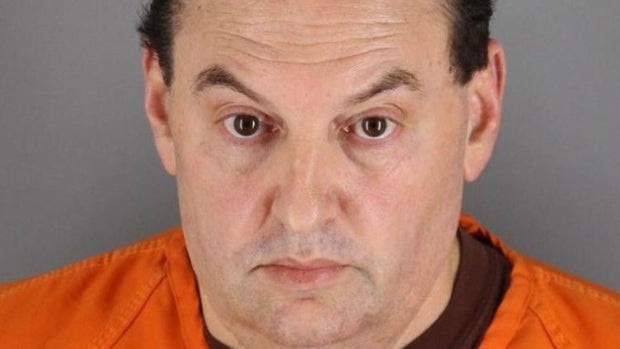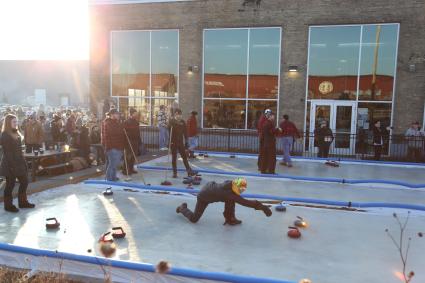Minneapolis, MN
Rare clue at Minneapolis crime scene points to a barefoot killer

It was a grisly scene when police arrived at a Minneapolis apartment complex on June 13, 1993, to investigate the murder of 35-year-old Jeanie Childs. Her body was found partially under her bed, her bedroom was in disarray, and there was blood spatter across the walls and floor. Childs had been stabbed more than 60 times. As investigators tried to piece together what unfolded, they found a rare clue in the bedroom: bloody, bare footprints.
“That drew my attention right away … I mean, wow,” Bart Epstein, a retired forensic scientist, told “48 Hours” correspondent Erin Moriarty in “The Footprint,” airing May 17 at 10/9c on CBS and streaming on Paramount+. “You don’t see this at crime scenes in general, bare feet that have stepped in blood,” said Epstein.
Investigators knew the footprints had to belong to Childs’ killer because she was wearing socks at the time of her death. Those footprints had to have been left there after the perpetrator stepped in her wet blood after the murder. Investigators documented and photographed the footprints.
“So the footprints, beyond being something that would tend to show guilt, also was important to show to clear people who might have been under any suspicion,” said retired FBI agent Chris Boeckers, who would later join the investigation.
According to the case file, investigators compared the footprints left at the crime scene to multiple people, including a man named Arthur Gray, whom Childs lived with at the time of her murder. According to police reports, authorities found hairs stuck to Childs’ left hand and one of those hairs matched Gray.
But Boeckers says the case against Gray started to fall apart pretty quickly. “He had a really solid alibi that he was out of town that weekend that was corroborated by others.” Gray, who enjoyed riding motorcycles, told authorities he was in Milwaukee. Forensic scientists also examined Gray’s footprints and determined he did not leave those footprints at the crime scene.
Days turned into years and then decades without finding the individual who left those footprints. In 2015, forensic scientist Andrea Feia, who was asked to do DNA testing on items collected at the crime scene, determined there was an unknown DNA profile that kept repeating itself. It was found on the comforter, a towel, a washcloth, a T-shirt and on the bathroom sink.
Investigators then turned to investigative genetic genealogy for answers. A forensic genealogist submitted the unknown DNA profile to genealogy websites. “The forensic genealogist indicated she had a match to potentially two brothers here in Minnesota,” Boeckers said. One of those brothers was businessman and hockey dad Jerry Westrom.
Investigators were anxious to confirm that the unknown crime scene DNA was indeed Westrom’s, but to do that, they needed to track him down. In January 2019, investigators followed Westrom to his daughter’s college hockey game in Wisconsin and obtained a napkin and food container he had used after eating at the arena. They took the items to the lab for testing and the results revealed there was a match.
The following month, in February 2019, Westrom was arrested for the murder of Childs. During his police interview, Westrom denied being at the apartment and knowing Childs. The next day, authorities collected his footprints for comparison.
Although Westrom’s DNA was at the scene, it was important to confirm the footprints belonged to him because there was other male DNA found at Childs’ apartment that did not belong to Westrom.
Mark Ulrick, a supervisor with the Minneapolis Police Forensic Division, examined the footprints. “In Minnesota here, people are not committing crimes a lot of times with the socks and shoes off,” he told “48 Hours.” He says he focused on the friction ridge skin — the arrangement of ridges and furrows — unique to every person. “Friction ridge skin is found on … your fingers, your palms, and the soles of your feet,” Ulrick explained. During his examination, he compared the unknown footprints to Westrom’s prints and to those of alternate suspects.
Westrom’s defense team hired its own forensic scientist, Alicia McCarthy, to verify Ulrick’s work. What would the experts conclude about the footprints? Watch “The Footprint” Saturday, May 17 at 10/9c on CBS and streaming on Paramount+.

Minneapolis, MN
Freeloader Friday: 129 Free Things To Do This Weekend – Racket

Freeloader Friday is your weekly guide to having fun no matter what your budget looks like. Each week we have a list of 100% free events like gallery parties, music, and films in the park, as well as free admission events like special happy hours, markets, and more.
FRIDAY
CCU Friday Night Open Mic
It’s back! Read more about Comedy Corner Underground’s move and plans for the future here. 10 p.m. Whitey’s Old Town Saloon, 400 E. Hennepin Ave., Minneapolis.
Christmas-Themed Pitch-a-Friend
Friends give a pitch on why you should date their buds. Read more about the series and what to expect here. 21+. 7 p.m. La Doña Cervecería, 241 Fremont Ave. N., Minneapolis.
429 Wabasha Holiday Party
Featuring an ugly Christmas sweater and blindfolded cookie decorating contests, White Elephant gift exchange, treats, and discounts. 6-10 p.m. Back Pocket Vintage and Wabasha Brewing, 429 Wabasha St. S., St. Paul.
How the Grinch Stole Christmas
Free popcorn and a movie. 8-10 p.m. Insight Brewing, 2821 E. Hennepin Ave., Minneapolis.
Creekview Winter Solstice
Featuring an illuminated walking path, a bonfire, winter treats, and a mini craft market. 5-7 p.m. Creekview Park, 5001 Humboldt Ave. N., Minneapolis.
Have Yarrrhself a Lusty Busty Xmas
Fortune’s Fool Theatre celebrates 20 years with two free concurrent shows, the other being Yarrrh! The Lusty, Busty Pirate Musical. Free. The Hive Collaborative, 677 Hamline Ave. N., St. Paul; find dates and reserve tickets here. Through December 21
Oisterboy
Punk. With Spencer Cameron & Jackson Kates, and rickie. 6-8 p.m. White Squirrel Bar, 974 W. Seventh St., St. Paul.
The Gated Community
7-9 p.m. Animales BBQ Co., 241 Fremont Ave. N., Minneapolis.
Oliver Phibes
With Unattractive Giant Monster, Dado Set. 9-11:30 p.m. White Squirrel Bar, 974 W. Seventh St., St. Paul.
Le Cirque Rouge Burlesque & Cabaret
10 p.m. 331 Club, 331 13th Ave. NE, Minneapolis.
Kingsview
7-10 p.m. Inbound BrewCo., 701 N. 5th St., Minneapolis.
Friday Night Karaoke
7 p.m. Boom Island Brewing, 5959 Baker Rd., Minnetonka.
Nick Elstad Trio & Michael Gay
7-9 p.m. 56 Brewing, 3055 NE Columbia Ave., Suite 102, Minneapolis.
Grungemas
6-9 p.m. Heavy Rotation Brewing Co., 9801 Xenia Ave. N., Minneapolis.
Radio Helix: Live Radio Talk and Variety Show
5:15-8 p.m. Padraigs, 945 Broadway NE, Minneapolis.
Singalong with the Songfellows
7-9 p.m. Urban Forage Winery and Cider House, 3016 E. Lake St., Minneapolis.
Tumblin’ Dice
8-11:30 p.m. Schooner Tavern, 2901 27th Ave. S., Minneapolis.
The Muppet Christmas Carol
Free popcorn and cocoa. 7 p.m. East Side Freedom Library, 1105 Greenbrier St., St. Paul.
FriGAY
Drag performances, a dance party, and $2 specialty shots–sounds like a party! 21+. 9 p.m. RSVP recommended; do it here. LUSH Lounge & Theater, 990 Central Ave. NE, Minneapolis.
Festival of Trees
Walk along a trail featuring 75 uniquely decorated trees created by local businesses and organizations. Mall of America, North Atrium Level 3, 60 E. Broadway, Bloomington. Through January 5
Dayton’s Holiday Window Displays
This season, 50th and France has two magical shop windows on display using figurines and decor from the original department store. Both were curated by Douglas Flanders, a longtime gallery owner who passed away recently. Douglas Flanders & Associates, 5025 France Ave. and Local Love Markets, 3924 W. 50th St.
HOLIDAY MARKETS
10th Annual Nordic Julmarket
Music and a mini pop-up market. 11 a.m. to 4 p.m. Fri.-Sat.; 11 a.m. to 3 p.m. Sun. Norway House, 913 E. Franklin Ave., Minneapolis.
The Artful Present
This holiday event includes a group show, local artists’ market, and more. and pop-up includes art and gifts from local artists. Today’s opening-day reception includes live music and a guest jewelry shop 4-7 p.m. Otherwise hours are 11:30 a.m. to 3 p.m. Thu.-Fri.; noon to 4 p.m. Sat. Veronique Wantz Gallery, 901 N. Fifth St., Minneapolis. Through December 20
Dayton’s Holiday Market
Downtown is back? Well, this annual pop-up shop is, at least. Now in its fifth year, Dayton’s Holiday Market does the old department store one better, hosting over 100 local makers and brands, including Love Your Melon gear, artisan giftables, and unique sports merch from Minnesota teams. Or maybe food and booze is more your thing? The market will also host Oak Grill Culinary Classics, which will serve up wild rice soup and pastries from local bakeries, and the Jingle Giles Bar, which, according to the release, will offer “festive cocktails, mocktails, meatballs,” and other treats. Folks too scared to venture downtown fear not, as a satellite market will be setting up shop in Southdale Center later this month (personally, I’d take an empty downtown over an empty mall any day). Dayton’s, 700 Nicollet Mall, Minneapolis. Through December 27—Jessica Armbruster
Dayton’s Holiday Market: Southdale
Same deal, different mall. With over 50 local vendors. Southdale Center Dining Pavillion, Level 2, Southdale Center, 2015 Southdale Center, Edina. Through December 24
European Christmas Market
This is the big one, folks. The one that is more of a festival. The one where you can pick up your own stein. This huge holiday market is modeled after classic markets popular throughout Europe (the first known event of this kind being in Dresden in 1434). During this annual outdoor festival there will be live entertainment, with traditional music and dance performances. The VIPs of the fest are Santa and Krampus, who will be on hand, as will reindeer, sled dogs, and elves. There will be tons of food, such as giant pretzels, fresh roasted nuts, Swedish meatballs, churros, waffles, spaetzle cheese curds, and all kinds of party weinies. Also good to know: There will be lots of hot bevvies, whether you’re looking for coffee, cocoa, or glühwein. Or bust out that market stein and order up a beer. Find more info at stpaulchristmasmarket.org. Free. 3-9 p.m. Fri.; 11 a.m. to 9 p.m. Sat.; 11 a.m. to 6 p.m. Sun. Union Depot, 214 Fourth St. E., St. Paul. Through December 21—Jessica Armbruster
Holiday Market
6-10 p.m. Fri.; noon to 8 p.m. Sat.; 11 a.m. to 6 p.m. Sun. Tilsner Artist Lofts, 300 Broadway St., St. Paul.
Holidays on Nicollet
Minneapolis Craft Market hosts this pop-up shop with over 60 local artists and makers. 10 a.m. to 5 p.m. daily through December 21. IDS Center, 747 Nicollet Mall, Minneapolis; find more info at mplscraftmarket.com.
Minneapolis Christkindl Market
Have you traveled through time, fortuitously arriving at a 16th-century German Christkindl market? Or are you in the North Loop? OK, unless you are having some kind of mental break or decided to hit a nearby dispensary way, way too hard, you’re not going to confuse the two. (That’s probably for the best; Europe used to be pretty gross.) Still, it’s fun to stroll through “time” at these holiday events in a Ren Fest kind of way. During festivities, guests will be able to partake in food and warm drinks including spiced glühwein, gooey raclette cheese, heart-shaped Nordic waffles, French galettes, and Polish pastries. There will be shoppin’ too, with over 30 vendors selling things like traditional ornaments, wooden toys, nutcrackers, steins, beeswax candles, socks, and more. The weekly lineup of entertainment onstage features traditional old world holiday music and dance, and Santa and Krampus will be stopping by too. Free. 4-9 p.m. Fri.; 11 a.m. to 9 p.m. Sat.; 11 a.m. to 7 p.m. Sun. North Loop Green, 350 N. Fifth St., Minneapolis; find more here. Through December 21—Jessica Armbruster
Raging Art On
Shop all kinds of rockin’ items from 70+ local artists, plus family-friendly entertainment and crafts every Sat. Free. 11 a.m. to 7 p.m. Thu.-Sat. Gamut Gallery, 717 S. 10th St., Minneapolis. Through December 21
SATURDAY
Open Curling
In assembling (and updating) Racket’s annual guide to local holiday markets, we see a lot of the same stuff from place to place: food trucks, festive beers, vintage goods. And hey, all of that is great. But very rarely do you see a holiday market that also has free open curling, as this one at Fridley’s Forgotten Star does. You’ll have a chance to curl during this Saturday’s holiday market or next Saturday’s, and they’re offering a series of free lessons in 2026 to boot. Noon to 6 p.m. Forgotten Star Brewing Company, 38 Northern Stacks Dr., Fridley; find more info here.—Em Cassel
Darkest Day
Not to be confused with Darkness Day, Darkest Day at Broken Clock is a celebration of… well, the darkest day of the year, aka the Winter Solstice. As the brewery does every year, they’re honoring it with the release of four new limited, aged Russian imperial stouts: Bourbon Barrel, Rum Barrel, Rum Barrel with Coconut, and Double Barrel (port wine and bourbon). Nothin’ like a strong beer to get ya through the long dark day, and remember: It gets sunnier from here on out. “Cheers to the longest night—and the brighter days ahead,” Broken Clock writes. Hear, hear. Free. Noon to 11 p.m. Broken Clock Brewing Cooperative, 1712 Marshall St. NE, Ste. 100, Minneapolis; find more info here.—Em Cassel
Cannabis Classroom: Christmas Edition
A cannabis butter infusion class and cookie decorating party with the Green Witch, Natty Cakes, and Hers & Gerbs. RSVP is required; text CannaCookie to 763-290-0170. 21+. 11 a.m. to 2 p.m. Heal Mpls, 4171 Lyndale Ave. N., Minneapolis.
Native Market & Cultural Celebration
Featuring chef and author Sean Sherman and Kate Nelson, music from Wenso Ashby, a community clothing giveaway, and a market with handmade goods, art, jewelry, foods, and culturally-rooted products. Noon to 3 p.m. Midtown Global Market, 920 E. Lake St., Minneapolis.
3rd Annual All Taproom White Elephant Party
Bring a wrapped gift for a raffle ticket to receive a new, possibly crappier gift—or a chance at a $200 gift card to Insight. 6-8 p.m. Insight Brewing, 2821 E. Hennepin Ave., Minneapolis.
Winter Solstice Light Ride
Travel along a riverfront/downtown route ending at Modist Brewing. A $50 gift card prize will go to the best decorated bike. 5 p.m. Behind Bars Bicycle Shop, 208 13th Ave. NE, Minneapolis.
Cole Diamond
10 p.m. 331 Club, 331 13th Ave. NE, Minneapolis.
Becky Kapell and the Fat 6
7 p.m. Animales BBQ Co., 241 Fremont Ave. N., Minneapolis.
Molly Maher Duo
3 p.m. Animales BBQ Co., 241 Fremont Ave. N., Minneapolis.
Ambient Toad
With RJ Vocal, Helen. 1-4 p.m. White Squirrel Bar, 974 W. Seventh St., St. Paul.
Fuzzy Math
6-8 p.m. White Squirrel Bar, 974 W. Seventh St., St. Paul.
Le Cirque Rouge Holiday Show
9 p.m. to midnight. White Squirrel Bar, 974 W. Seventh St., St. Paul.
Tyler Herwig
6:30-9:30 p.m. Padraigs, 945 Broadway NE, Minneapolis.
Jiggs Lee Invasion
8 p.m. Schooner Tavern, 2901 27th Ave. S., Minneapolis.
The PhilBillies
7 p.m. Urban Forage Winery and Cider House, 3016 E. Lake St., Minneapolis.
Locktunes
7:30 p.m. Merlin’s Rest Pub, 3601 E. Lake St., Minneapolis.
Winter Solstice
Lanterns light up the night. 6-9 p.m. Powderhorn Park Rec. Center, 15th Ave. S., Minneapolis.
Jazz Outlaws
Enjoy Vince Guaraldi’s Charlie Brown Christmas and original tunes. 8-11 p.m. Dusty’s Bar, 1319 Marshall St. NE, Minneapolis.
Jason Bradley
Acoustic tunes. 7 p.m. Broken Clock Brewing Collective, 1712 Marshall St. NE, Minneapolis, Minneapolis.
The Giant Valley String Band
6-10 p.m. Heavy Rotation Brewing Co., 9801 Xenia Ave. N., Minneapolis.
“Architecture Interpreted”/“In Between Moments”/”My Floating World: Views from Pacific Coast Highway”
Check out three new shows in one gallery. 6-8 p.m. Praxis Gallery & Photographic Arts Center, 2601 27th St. S., Minneapolis.
Fourth Degree Holiday Show
Jazz, pop, classic rock. 6-8 p.m. Boom Island Brewing Company, 5959 Baker Rd., Minnetonka.
Girls’ Day Out Holiday Edition
Featuring a Diet Coke bar, hair tinsel, and a pop-up tattoo shop. 10 a.m. to 3 p.m. Jenny in the City, 520 Selby Ave., St. Paul.
Winter Solstice
A Huitzilopochtli event featuring a ceremonial danza Mexica and a free community meal. 10 a.m. to 3 p.m. Eastview Recreation Center, 1675 Fifth St. E., St. Paul.
Santa & Albert’s Holiday Play
A cute, 20-minute play about holiday shenanigans followed by a sing-a-long and Santa meet-and-greet. Sat.-Sun. Bachman’s Floral, Gift & Garden, 6004 S. Lyndale Ave., Minneapolis; find showtimes and more info here. Through December 21
Free Yoga
Studio 9-to-5 hosts free yoga sessions Mon., Wed., and Sat. Sign up here. 9 a.m. Union Depot, 214 Fourth St. E., St. Paul.
HOLIDAY MARKETS
ArtYouHeart Holiday Pop-Up
This south Minneapolis pop-up brings together three local poster collections—ArtYouHeart, ARTCRANK, and Posters for Parks—under one roof. Browse original posters and more. 10 a.m. to 5 p.m. Replace Studio, 5008 34th Ave. S., Minneapolis.
Field + Festival Holiday Market 2025
Minneapolis Craft Market hosts this weekly market offering eats from local farmers and artisans. 10 a.m. to 2 p.m. Sat.-Sun. Wagner’s Garden Center, 6024 Penn Ave. S., Minneapolis.
Final Countdown Holiday Market
Shop 7 local makers and meet llamas. 10 a.m. to 4 p.m. Larissa Loden HQ, 2032 Marshall Ave., St. Paul.
Forgotten Star Holiday Market
Shop 30+ vendors and enjoy a holiday beer release, beer poking, and free open curling. Noon to 6 p.m. Forgotten Star Brewing, 38 Northern Stacks Dr., Fridley.
A Handmade Holiday Market
Local makers and crafters. Noon to 5 p.m. Sat. Brühaven Craft Company, 1368 Lasalle Ave., Minneapolis.
Handmade Holigays
Pick up last-minute gifts and support local vendors. Produced by Modesitt Markets. Noon to 6 p.m. Queermunity MN, 3036 Hennepin Ave., Minneapolis.
Holiday Gallery Shop
A juried collection of artisan goods for gifting from 100+ artists. Textile Center, 3000 University Ave. SE, Minneapolis; textilecentermn.org. Through December 31
Holiday Glass Marketplace: Design & Dazzle
With live glassblowing demonstrations, ornaments and other giftables for sale, and festive glasswork. Noon to 5 p.m. Foci – Minnesota Center for Glass Arts, 2213 Snelling Ave., Minneapolis.
Holiday Lane at Northrup
Shop from hundreds of artists at this weekly holiday happening. 10 a.m. to 4 p.m. Northrup King Building, 1500 Jackson St. NE, Minneapolis.
Holiday Market
This ongoing pop-up market includes local makers, artists, vintage sellers, and more. 11 a.m. to 5 p.m. Sat.-Sun. AudreyRose Vintage, 3508 Snelling Ave., Minneapolis.
Holiday Market
5-8 p.m. OMNI Winery & Taproom, 15701 Biscayne Ave., Rosemount.
Indigenous Holiday Market
With live music and 20 Indigenous vendors. Noon to 4 p.m. Indigenous Roots Cultural Arts Center, 788 E. Seventh St., St. Paul.
Jul Shop
Shop Nordic gifts at this annual pop-up shop through January 25. The American Swedish Institute, 2600 Park Ave., Minneapolis.
Made by Hands Holiday Market
Makers, artists, and more. Noon to 6 p.m. Sat.-Sun. Bauhaus Brew Labs, 1315 Tyler St. NE, Minneapolis.
Mill City’s Indoor Winter Market
This long running market features local, sustainable, and organic groceries and produce, as well as handmade gifts and goods. For the season, the market moves inside Mill City Museum (museum admission is not required). Winter Markets are held on the first and third Saturdays of each month through April. 10 a.m. to 1 p.m. 704 S. Second St., Minneapolis; millcityfarmersmarket.org.
Minnesota Merry Market
Featuring over 80 vendors each weekend, with two bars, kids’ fun, Santa, food trucks, ice games, train rides, horse-and-carriage rides, and more. Free. 10 a.m. to 4 p.m. Sat.-Sun. Minnesota State Fairgrounds, 1265 Snelling Ave. N., St. Paul; minnesotamerrymarket.com.
Nicollet Island Last Chance Market
Featuring over 50 local vendors. 10 a.m. to 4 p.m. Nicollet Island Pavilion, 40 Power St., Minneapolis.
Nordic Village Winter Market
It’s back! Featuring European-style market where little houses are shops. 11 a.m. to 3 p.m. Sat.-Sun. Four Seasons Minneapolis, 245 Hennepin Ave., Minneapolis.
Pop-up Holiday Market
Shop 11 local artists, including TruthLizard. 2-7 p.m. Resource Mpls, 512 E. 24th St., Minneapolis.
Slacker Sk8er Market
Enjoy last-minute panic shopping with chain mail, VHS, vintage clothing, and miscellaneous weird stuff. 10 a.m. to 3 p.m. Pilllar Forum, 2300 Central Ave. NE, Minneapolis.
Wild Vintage Market
The monthly market returns in time for last-minute holiday stuff. 11 a.m. to 4 p.m. Clapping Monkey, 7274 Commerce Cir. E, Fridley.
Winter Table & Open Studios
Explore open studios followed by a cozy potluck at 6:30 p.m. Noon to 10 p.m. Q.arma Building, 1224 Quincy St. NE, Minneapolis.
FARMERS MARKETS
Lowertown St. Paul Farmers Markets
Lowertown’s pride and one of the state’s largest markets. Find free parking on Prince Street. 7 a.m. to 1 p.m. Sat.; 8 a.m. to 1 p.m. Sun. through Apr. 19. 290 Fifth St. E., St. Paul; stpaulfarmersmarket.com.
Mill City Farmers Market
The yearlong market moves indoors this weekend for its fall/winter schedule. 9 a.m. to 1 p.m. every first and third Sat., Nov. through Apr. 750 S. Second St., Minneapolis; find more info at millcityfarmersmarket.org.
Minneapolis Winter Farmers Market
9 a.m. to noon Dec. 6-20, Jan. 10 & 24, Feb. 7 & 21, March 7 & 21, and Saturdays through April. Minneapolis Farmers Market Site, 312 E. Lyndale Ave. N., Minneapolis; find more info at mplsfarmersmarket.com.
Richfield Winter Farmers’ Market
11 a.m. to 3 p.m. Richfield Community Center, 7000 Nicollet Ave. S., Minneapolis; find more info here. Saturday’s through December 20
St. Paul Indoor Farmers Market
Shopping in nature? Pffft. This one lets you shop for greens without the weather. 9 a.m. to 1 p.m. Sat.-Sun. through April 18. 308 Prince St., St. Paul; stpaulfarmersmarket.com.
SUNDAY
Be the Light Winter Solstice Walk
A luminary walk witch visual messages from the community. Registration is required; you can sign up here. 6-8:30 p.m. Westwood Hills Nature Center, 8300 W. Franklin Ave., St. Louis Park.
“Wrap Me in a Blanket”
Artist Olivia Morawiecki honors community stories of love and loss with a visual and sound installation. 4 p.m. Lowell Park, 201 Water St. N., Stillwater.
Longfellow Rising Midwinter Celebration
This friendly neighborhood walk features stops by murals with caroling, poetry, and more, ending with hot drinks from around the world at Pangea World Theater. 3:30-5:30 p.m. Meet at Holy Trinity Lutheran Church, 2730 E. 31st St., Minneapolis.
Home Alone
Free movie and popcorn. 7 p.m. Roxy’s Cabaret, 1333 Nicollet Mall, Minneapolis.
Winter Solstice Celebration
Featuring fire pits, beer poking, a new barrel-aged beer release, intention burning, and more. 2-6 p.m. Urban Growler Brewing Company, 2325 Endicott St., St. Paul.
Sunday with Santa
This one’s for the kids, gang. With ornament making and Santa photo ops. Noon to 3 p.m. BlackStack Brewing, 755 Prior Ave. N., St. Paul.
Clover and the Bee
3 p.m. Animales BBQ Co., 241 Fremont Ave. N., Minneapolis.
eleven degenerates
10:30 p.m. 331 Club, 331 13th Ave. NE, Minneapolis.
Switchyard
7 p.m. 331 Club, 331 13th Ave. NE, Minneapolis.
Robert Wilkinson
3-5 p.m. 331 Club, 331 13th Ave. NE, Minneapolis.
East Lake Jazz Christmas Show
1-4 p.m. White Squirrel Bar, 974 W. Seventh St., St. Paul.
Bingo With Pete
6-8 p.m. White Squirrel Bar, 974 W. Seventh St., St. Paul.
Karaoke With Ally
9 p.m. to midnight. White Squirrel Bar, 974 W. Seventh St., St. Paul.
Church of Cornbread
A weekly Cornbread Harris jam. 5-7 p.m. Schooner Tavern, 2901 27th Ave. S., Minneapolis.
Drag Discovery Night
An open stage night for drag, hosted by Luna Muse and mentored by Rose Nylon. Sign up here. 7 p.m. LUSH Lounge & Theater, 990 Central Ave. NE, Minneapolis.

HOLIDAY MARKETS
Gothmas
Midnight Creatures Market sets up a market with clothing, bone-themed home decor, risograph prints, and leather goods. Noon to 4 p.m. Odd Mart, 2520 Lyndale Ave. S., Minneapolis.
Minneapolis Vintage Market
Shop vintage on two floors. With coffee and DJ tunes. 11 a.m. to 4 p.m. Machine Shop, 300 Second St. SE, Minneapolis.
Unlimited Goes Hollywood Makers Market
Shop over 40 local vendors. Noon to 4 p.m. Hollywood Theater, 2815 Johnson St. NE, Minneapolis.
Minneapolis, MN
ICE put themselves, others at risk during south Minneapolis operation, former agent says

During an ICE operation on Monday, WCCO’s cameras caught the stunning moment that an Immigration and Customs Enforcement agent dragged a woman along the ground by her arm, with her wrist seemingly attached to that of the federal officer’s by a restraint.
At WCCO’s request, Eric Balliet reviewed the footage. He spent 25 years with the agency now known as ICE, serving as a special agent who would go on to lead the ICE equivalent of internal affairs.
“I’ve arrested dozens upon dozens of human traffickers, human smugglers, child molesters, you name it. I’ve never dragged a suspect one-handed across a street,” Balliet said.
According to ICE, agents found themselves in what they are calling a “riot” in south Minneapolis after pulling over a car with two people facing immigration charges. Officers allege in court documents that a woman attempted to vandalize ICE vehicles with spray paint — the crowd began forming as ICE attempted to detain her.
WCCO’s cameras arrived with two officers surrounded by protesters; one of them was waving around a weapon that deploys chemical spray. The other was kneeling on top of the woman, his wrist attached to hers with the restraint, using his other arm to wave around a Taser. Both of the officers fired their respective weapons; after using his Taser, that officer taunted the crowd, asking “who wants more?”
It was after this incident that the woman got up and tried to run. She was then dragged across the floor by the agent with the Taser before he detached from her; some in the crowd threw snowballs while his partner fired chemical spray in return.
Balliet said that these use-of-force tactics should be under review. He said that the agents appeared overwhelmed, highlighting what to him seemed to be poor operational planning and execution.
Balliet said that too often he sees agents unable to safely handle situations that they should never have put themselves in in the first place.
“There seems to be either a blatant disregard for training or a lack thereof, either of which is troubling and puts the agents and the general public at risk,” Balliet said.
In a lengthy statement released on Thursday, an unnamed ICE spokesperson said that officers are showing restraint against “rioters.” ICE did not respond to WCCO’s questions about whether dragging someone along the floor by a restraint or verbally taunting a crowd of protesters is standard protocol. The agency also failed to say if any of the agents involved on Monday face internal discipline.
“ICE and CBP are trained to use the minimum amount of force necessary to resolve dangerous situations to prioritize the safety of the public and themselves. Our officers are highly trained in de-escalation tactics and regularly receive ongoing use of force training,” the statement reads in part.
In an interview with 60 Minutes in October, President Trump endorsed ICE agents using force in residential neighborhoods in cities throughout the country. This came after an incident in Illinois where cell phone video showed federal agents standing several stories above protesters and shooting less-than-lethal munitions towards their heads and torsos.
Protesters and media organizations in Chicago filed a complaint in federal court about tactics in the Chicago area as well as those captured on video recordings in Portland, Oregon; Los Angeles and other cities. In early November, U.S. District Court Judge Sara L. Ellis issued an order blocking federal agents from deploying chemical spray, tear gas or any other less-lethal weapon “unless such force is necessary to stop the immediate threat of physical harm to another.”
The Trump administration has filed an appeal.
On Monday, ICE confirmed the arrest of four people. WCCO learned that the two people detained on immigration charges are an Ecuadorian couple in their early 20s; agents shattered their car window before detaining the pair. The other two arrested are U.S. citizens who ICE alleges assaulted officers; however, WCCO could only find evidence that one of the men is actually facing criminal charges.
According to ICE, a man named Noor Abdikadir is still in custody for assaulting an officer. WCCO could not find any publicly available information regarding any kind of charges; ICE is ignoring clarifying questions about his whereabouts and alleged crimes.
A man with a very similar name, Abdikadir Noor, is among six people who are suing ICE for civil rights violations with the assistance of the American Civil Liberties Union of Minnesota. In the lawsuit, the Somali-American said that ICE tackled him during Monday’s operation without provocation, leaving him with injuries. He stated that he was among the first on scene, driving to the nearby Karmel Mall when he noticed ICE pull over the car behind him. He said that once the crowd began to form he tried to keep the peace.
Noor said that once he was released from the Whipple Federal Building at Fort Snelling, where ICE operates from, he was given no documentation or explanation for why he was arrested in the first place.
While ICE failed to identify whether they have a different man still in custody, WCCO could identify documentation for the other man, Maxwell Collyard. In a complaint written by HSI Special Agent Michael Raiff, agents accuse Collyard of being part of the “mob” throwing ice, snow, rocks and other objects following Monday’s vehicle stop.
Collyard allegedly repeatedly ignored commands from ICE officers to back up and instead threatened officers on scene.
At one point, an officer sprayed Collyard with “oleoresin capsicum” spray, a chemical agent. After this, the complaint alleges that Collyard and others tackled one of the officers while they were attempting to detain the woman seen pinned on the floor. From here, the complaint states that Collyard followed the agents involved away from the scene in his pickup truck; this is where officers arrested him. According to court records, he’s now under house arrest.
In audio released by the Hennepin County Sheriff’s Office, a supervisor with the ICE operation based in St. Paul called for help from local law enforcement. Deputies with the Hennepin County Sheriff’s Office and officers with the Minneapolis Police Department responded, only to find no evidence that agents were in life-threatening danger.
Balliet said from what he saw, there is evidence that ICE agents are deploying to cities like Minneapolis without being properly equipped to handle the public backlash.
“I feel like it falls on the lack of leadership, the lack of accountability, poor training, poor operational planning, poor execution,” Balliet said.
Minneapolis, MN
Bystanders throw snowballs at ICE agents dragging woman on the ground in Minneapolis – video

US federal agents were filmed dragging a woman and pinning her down in the snow for several minutes in Minneapolis, Minnesota, on Monday. Bystanders pleaded with the agents to let the woman go and threw snowballs at them. The Minneapolis police chief, Brian O’Hara, criticised the ICE tactics after the incident
-

 Iowa5 days ago
Iowa5 days agoAddy Brown motivated to step up in Audi Crooks’ absence vs. UNI
-

 Iowa6 days ago
Iowa6 days agoHow much snow did Iowa get? See Iowa’s latest snowfall totals
-

 Maine3 days ago
Maine3 days agoElementary-aged student killed in school bus crash in southern Maine
-

 Maryland5 days ago
Maryland5 days agoFrigid temperatures to start the week in Maryland
-

 Technology1 week ago
Technology1 week agoThe Game Awards are losing their luster
-

 South Dakota5 days ago
South Dakota5 days agoNature: Snow in South Dakota
-

 Nebraska1 week ago
Nebraska1 week agoNebraska lands commitment from DL Jayden Travers adding to early Top 5 recruiting class
-

 Detroit, MI4 days ago
Detroit, MI4 days ago‘Love being a pedo’: Metro Detroit doctor, attorney, therapist accused in web of child porn chats

































